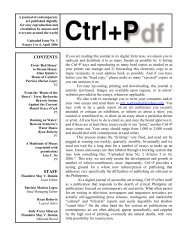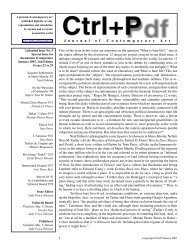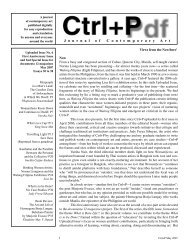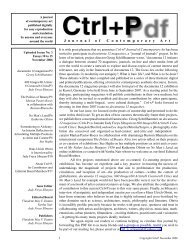Issue 15 - Pdf Ctrl+P - CTRL+P: a journal of contemporary art
Issue 15 - Pdf Ctrl+P - CTRL+P: a journal of contemporary art
Issue 15 - Pdf Ctrl+P - CTRL+P: a journal of contemporary art
Create successful ePaper yourself
Turn your PDF publications into a flip-book with our unique Google optimized e-Paper software.
Governments have had little interest in regulating the trinkets and playthings<br />
<strong>of</strong> the super-rich. Art works are a uniquely portable and confidential form <strong>of</strong><br />
wealth. Whereas all property purchases have to be publicly registered, buying<br />
<strong>art</strong> is a private activity. And unlike old masters, which are <strong>of</strong>ten linked by<br />
history to specific places, <strong>contemporary</strong> <strong>art</strong> knows no frontiers. 4<br />
Take for example, in the midst <strong>of</strong> the financial market bubble, the <strong>art</strong> market inflation<br />
was ridiculously exaggerated: the Chinese painter Zhang Xiaogang saw his work<br />
appreciate 6,000 times, from $1,000 to $6 million between 1999-2008; while the American<br />
<strong>art</strong>ist Richard Prince’s work went up 60 to 80 times between 2003-2008. 5<br />
In some ways, the <strong>art</strong> market behaves more like executive salaries than the stock<br />
market. In appearance, both the <strong>art</strong>s and executive salaries seem to be based on merit<br />
—but the ratio between merit and performance is actually very opaque.<br />
The number is actually “a signaling mechanism,” explains Seth Godin, a marketing<br />
expert, regarding the myth <strong>of</strong> big executive salaries. In order to solicit the best and the<br />
brightest, firms compete with each other by engineering a salary structure that attempts<br />
to bid higher than a competing firm. Moreover, these firms have a board <strong>of</strong> directors<br />
consisting <strong>of</strong> executives from other companies, so the salaries <strong>of</strong> this elite group keep<br />
paying each other higher and higher salaries that explode out <strong>of</strong> proportion compared to<br />
salaries <strong>of</strong> other employees in the same company.<br />
The similarities go further. As executive salaries have been disconnected from performance,<br />
so has the value <strong>of</strong> <strong>art</strong> been disconnected with other known indicators<strong>of</strong> value.<br />
In a sobering and sometimes sarcastic essay written by Donald Kuspit, an <strong>art</strong> historian<br />
and philosopher, he points out how the irrational exuberance was less about the value <strong>of</strong><br />
<strong>art</strong> than it was about the value <strong>of</strong> money:<br />
The intrinsic value <strong>of</strong> these paintings has, whatever it is…never [made] them<br />
more valuable than the extrinsic value [at which they were acquired] by reason<br />
<strong>of</strong> their exchange value, that is, the money that becomes their equivalent.<br />
More crucially, recognized by money, they can no longer be recognized for<br />
what they <strong>art</strong>istically are. Nor can they be questioned and put in historical<br />
perspective... The price paid for a work <strong>of</strong> <strong>art</strong> becomes its absolute and<br />
authoritative value, even if the value the price implies is not p<strong>art</strong>icularly<br />
clear. It is presented without explanation—the price is the explanation. 6<br />
Fueled by the illusive promise <strong>of</strong> exorbitant returns, the <strong>art</strong> market lost its justification<br />
for <strong>art</strong> and became a market <strong>of</strong> markets. What Ben Lewis calls “specullecting” by<br />
the likes <strong>of</strong> Charles Saatchi may be all too common as an integral p<strong>art</strong> <strong>of</strong> the <strong>art</strong> world<br />
now. In the late 1990s Saatchi bought the work <strong>of</strong> young <strong>art</strong>ists, established a museum<br />
in which to display it, lent it to public museums, and used his celebrity status to attract<br />
media attention. He then sold p<strong>art</strong> <strong>of</strong> his collection at auctions. The works then came to<br />
be associated with the celebrity collector, diminishing the value <strong>of</strong> the <strong>art</strong> itself.<br />
Anyone who thinks that all they need to do is to try to outsm<strong>art</strong> the <strong>art</strong> market may<br />
have random success at best. There have been countless studies by economists showing<br />
the low rate <strong>of</strong> return on <strong>art</strong> if one were to use it as investment. Analysis <strong>of</strong> historical<br />
data from 1650 to 1960 shows that the real annual rate <strong>of</strong> return was 0.5% on paintings<br />
as compared to 2.5% on government bonds. Another figure was slightly more optimistic,<br />
but similar—2% real returns on paintings compared to 3.3% real interest rate <strong>of</strong> the<br />
Bank <strong>of</strong> England. 7<br />
This figure is dismal for investors, but what about the figure for working <strong>art</strong>ists?<br />
In his misguided defense <strong>of</strong> the <strong>art</strong> world (rather than the <strong>art</strong> market) in the IQ2US debate,<br />
Jerry Saltz says “1% <strong>of</strong> 1% <strong>of</strong> 1% <strong>of</strong> 1% <strong>of</strong> <strong>art</strong>ists actually make money. And even<br />
they barely do and usually only for a very short time.” This adds another dimension to<br />
our picture – do <strong>art</strong>ists actually benefit from the <strong>art</strong> market? If not, then how could they<br />
make a living in spite <strong>of</strong> the monstrous alliance between the <strong>art</strong> world and the financial<br />
<strong>Ctrl+P</strong> September 2009







